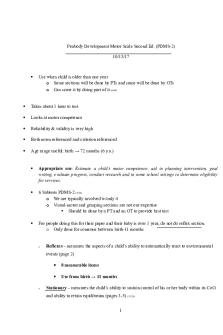Motor Development - Dr. Jennifer Ganger PDF

| Title | Motor Development - Dr. Jennifer Ganger |
|---|---|
| Author | Sara Pollak |
| Course | Developmental Psychology |
| Institution | University of Pittsburgh |
| Pages | 16 |
| File Size | 645.6 KB |
| File Type | |
| Total Downloads | 33 |
| Total Views | 123 |
Summary
Dr. Jennifer Ganger...
Description
Motor Development Thursday, February 11, 2021
2:22 PM
Reflexes: The first motor skills - Innate, fixed pattern of action that occurs in response to specific stimulation - Newborn Reflexes: (a sign of healthy development) ○ Sucking (will suck anything that enters their mouth) ○ Palmar grasp/Grasping (pressure on the palm; disappears 3-4 months) ○ Stepping ("disappears" around 2 months; "reappears" at 12 months?)
Motor milestones you should know (memorize) - Lifts head ○ By 4 weeks - Arms for support ○ 2-4 months - Reaching/grasping ○ 3-4 months - Sits without support ○ 5-7 months - Crawls 5 11 th (7 i )
○ 5-11 months (7 is average) - Walks alone ○ 11-14 months Understanding motor development - Traditional view: Maturation (Gesell) ○ Based on observation of orderly progression of motor milestones in Western culture ○ Chipping away at the traditional view § Many hints that multiple factors are important in motor developme - The stepping reflex ○ Does it drop out and reappear? ○ Water study (E. Thelen): infants who no longer exhibited stepping reflex on dry land showed it again when put into water ○ Added weight study (E. Thelen): stepping reflex goes away Cultural influence on motor development: walking - Urban China, rural Paraguay --> - West Africa, West Indies --> babies are stretched and suspended to build the muscles, and on average they learn to walk a few weeks sooner
t
r
Understanding motor development - These kinds of observations led to application of Dynamic Systems theory to motor development - Behavior is an integrated system
Dynamic systems framework: Multiple, interacting systems 1. CNS development ○ Synaptogenesis, myelination 2. Movement possibilities of the body (building new on old) ○ Pre-existing skills (e.g., postural control/balance --> reaching) ○ Body proportions 3. Motivation 4. Environmental supports/effects ○ Cultural differences § America: □ Dresses: easier to change diapers if the baby is wearing a dress but it makes it difficult to learn to crawl □ Face up to wake up: babies should be put to sleep on their backs, but then there's no motivation to use muscles to sit up so now "tummy time" is encouraged □ Walking in diapers: babies walk differently/better if not wearin
g
a bulky diaper § Orphanage studies: physical and emotional deprivation stunts mo (and physical and cognitive) development
Self-Locomotion and Depth Perception (?) - Visual cliff studies (Gibson & Walk; Campos & colleagues) ○ Crawlers show more hesitation than non-crawlers at the same age ○ Non-crawlers with walker manipulation learned to hesitate quickly
r
Self-Locomotion and Egocentrism - Piaget's egocentric representation ○ For infants, object locations are remembered relative to own position when location is first learned - Connection to self-locomotion ○ Crawling versus being carried to toy
Action and Knowledge: Active and Passive Motor Training - Sticky mittens --> Active training ○ Pre-reaching infants (~3 months) Mitt i
○ Mitten experience ○ Increased object exploration at 5 months and attention focusing skills a year later
- (Unintentional) Passive motor skill training ○ Participating in the study (passive training) for 6-8 sessions from 3 mon ○ Better motor outcomes at 6 months ○ Higher language skills at 10 months
Connection between self-generated motion and knowledge: Why? - Continuous spatial updating - Change in posture and behavior --> change in interaction with world; parenta ttit d di t ti
hs
attitude and interaction Self-Locomotion and Learning - Representations appear to be built through action - Is learning specific to each posture or motor skill? (Adolph & colleagues)
Developmental Cascade - Refers to how development across different systems all comes together and spreads across different domains...
Similar Free PDFs

Gross-Motor Development Essay
- 7 Pages

Chapter 5 Motor Development
- 22 Pages

Atu: Motor development
- 8 Pages

Jennifer Lawrence
- 1 Pages
Popular Institutions
- Tinajero National High School - Annex
- Politeknik Caltex Riau
- Yokohama City University
- SGT University
- University of Al-Qadisiyah
- Divine Word College of Vigan
- Techniek College Rotterdam
- Universidade de Santiago
- Universiti Teknologi MARA Cawangan Johor Kampus Pasir Gudang
- Poltekkes Kemenkes Yogyakarta
- Baguio City National High School
- Colegio san marcos
- preparatoria uno
- Centro de Bachillerato Tecnológico Industrial y de Servicios No. 107
- Dalian Maritime University
- Quang Trung Secondary School
- Colegio Tecnológico en Informática
- Corporación Regional de Educación Superior
- Grupo CEDVA
- Dar Al Uloom University
- Centro de Estudios Preuniversitarios de la Universidad Nacional de Ingeniería
- 上智大学
- Aakash International School, Nuna Majara
- San Felipe Neri Catholic School
- Kang Chiao International School - New Taipei City
- Misamis Occidental National High School
- Institución Educativa Escuela Normal Juan Ladrilleros
- Kolehiyo ng Pantukan
- Batanes State College
- Instituto Continental
- Sekolah Menengah Kejuruan Kesehatan Kaltara (Tarakan)
- Colegio de La Inmaculada Concepcion - Cebu











